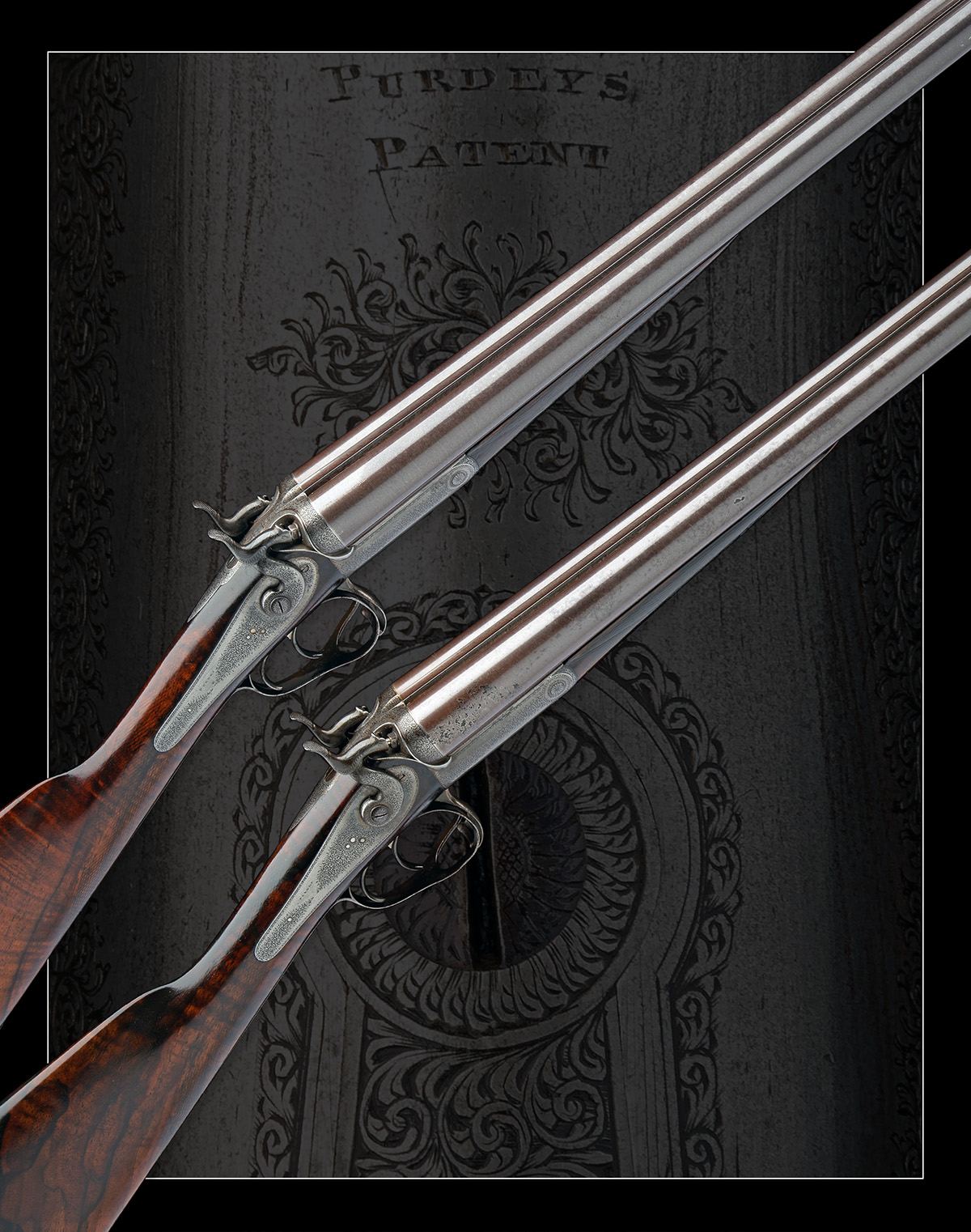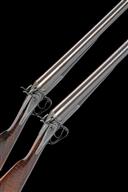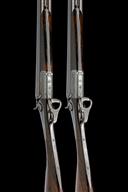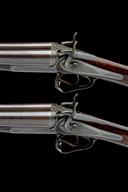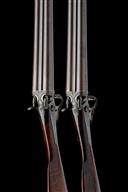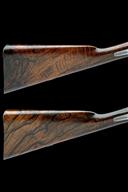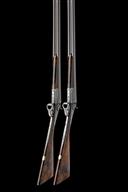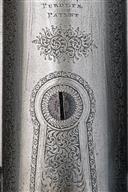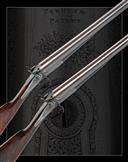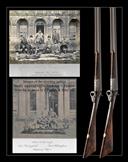Add to calendar
Product Details
J. PURDEY
A PAIR OF 12-BORE 1863 (SECOND PATTERN) THUMBHOLE-UNDERLEVER HAMMERGUNS, serial no. 7669 / 70,
for 1869, 30in. black powder only fine damascus barrels (No.1 with the new barrels by the makers in 1879, No.2 the originals), the rib inscriptions rubbed but No. 7669 with '1' visible and at the breech end 'CHOKE', 2 1/2in. chambers, No.1 bored approx. 1/4 and imp. cyl. choke, No.2 true cyl. in both, No.2 left wall at 19, actions incorporating J. Purdey 1863 second pattern thumbhole underlever and Purdey 1863 double bite, patent no. 1104 of 2nd May 1863, carved percussion fences, converted to rebounding island locks with dolphin hammers (by the makers in 1903), the standing breeches engraved 'PATENT', the flats marked 'No. 1' and 'No. 2', the undersides with 'PURDEY'S PATENT', best fine acanthus scroll engraving with floral bouquets, the lockplates signed 'PURDEY', minor squeeze marks to action bars, retaining very slight traces of original colour-hardening, 13 3/4in. boldly-figured stocks with engraved steel heel and toe plates, fore-ends with Anson push rod release catches, weight 6lb. 7oz. (No.1) and 6lb. 10oz. (No.2), together with a large wooden wall mount with large silver plaque, hallmarked for London 1970, makers mark for C.J. Vander Ltd (1886-2007) and inscribed "These 12 bore shot guns were made in 1867 by James Purdey at a cost of £126 for Charles, 3rd Lord Huntingfield 1818-1897 who first instituted partridge driving at Heveningham, about 1845 (Badminton Library) given by GP. CAPT. HON PETER VANNECK 1971"
Provenance: The makers have kindly supplied us with the following information:
No. 7669/7670
Completed: July 1869
For: Charles Andrew Vanneck, 3rd Baron Huntingfield
Description: A pair of non-rebounding backlock hammer game guns
Weight: 6lb. 12oz.
Calibre: 12-bore
Barrels: 30in. Damascus
Choke: Both Cylinder
Stock: 14 1/16in.
Cost: £126
Notes:
Built to match dimensions of No. 7498
Purdey thumblevers
Fitted with gold ovals, engraved with a coronet and 'H', at an extra cost of £2 5s
31 August 1876: Additional barrels fitted to both guns, choked Full & Modified, at a cost of £33 12s for both. Noted that the left barrel fires first
1884: The chokes of the No. 1 gun altered to both Modified
October 1903: Altered to rebounders on account of the Hon. William Vanneck (4th Baron)
Charles Andrew Vanneck, 3rd Baron Huntingfield of Heveningham Hall was born on 12 January 1818, son of Joshua Vanneck, 2nd Baron Huntingfield of Heveningham Hall. He died on 21st September 1897 at age 79 at Heveningham Hall.
He was educated between 1832 and 1835 at Eton College He succeeded as the 3rd Baron Huntingfield of Heveningham Hall and 5th Baronet Vanneck, of Putney, co. Surrey on 10 August 1844. He held the office of Deputy Lieutenant (D.L.) of Suffolk and the office of High Sheriff of Suffolk in 1848.
Lord Huntingfield is counted as one the top shots of the late nineteenth century, sharing the field with other notables such as Lord Walsingham, the Marquis of Ripon and Prince Duleep Singh and like them, favoured Purdey's as his gun of choice. He is credited with being the originator of driven partridge shooting at Heveningham during the 1850's.
Air Commodore Sir Peter Beckford Rutgers Vanneck, GBE, CB, AFC, 850th Lord Mayor of London (b.1922 d.1999) was the youngest son of Lord Huntingfield and American-born Margaret Eleanor Crosby. He was a British Royal Navy officer, fighter pilot, engineer, stockbroker and politician. He made notable contributions to Anglo-French relations as Lord Mayor of London and as a Member of the European Parliament.
He spent his early years in Australia during his father's tenure as Governor of Victoria in the 1930s. he was Educated at Geelong Grammar School, Stowe, Cambridge University and Harvard University.
He joined the Royal Navy during World War II. He served on HMS King George V during the operation to sink the Bismarck, and on HMS Eskimo. He commanded an LCA during service off North African coast and subsequently served on HMS Wren, part of the 2nd Escort Group under the command of Captain Johnnie Walker (the most successful anti-submarine unit of World War II). He commanded a Motor Torpedo Boat from August 1944 to the end of the war.
After the war, he trained as a pilot. On 30 September 1945, he transferred to 771 Naval Air Squadron of the Fleet Air Arm. He retired from the Royal Navy on 24 May 1949.
After leaving the Royal Navy, he matriculated at Trinity College, Cambridge. He joined the Cambridge University Air Squadron to further pursue his interest in flying and was commissioned into the Royal Air Force Volunteer Reserve as a flying officer on 17 November 1949.
He graduated from the University of Cambridge with a Master of Arts in engineering and then studied at Harvard University, USA, in 1953. While there, he was seconded to 101 Squadron Massachusetts Air National Guard, flying the P-51 Mustang.
In 1958, he transferred to No. 3619 (County of Suffolk) Fighter Control Unit based at RAF Nacton He was promoted to squadron leader on 1 July 1958. On 1 July 1962, he was promoted to group captain and appointed Inspector of the Royal Auxiliary Air Force.
He went into business with the engineering company Ransome's in Ipswich, followed by Rowe and Pitman (stockbrokers) in the City of London. He was appointed to the Council of the London Stock Exchange in 1968. He was Deputy Chairman from 1973 to 1975.
He was High Sheriff of Suffolk from 1974.
After a year serving as a Sheriff of London in 1974, he was elected the 650th Lord Mayor of London in November 1977.
As lord Mayor, he made excellent contacts with his Paris counterpart Jacques Chirac and arranged an official visit to visit (one of only two that had taken place since the French revolution).
He held position of Master of the Worshipful Company of Gunmakers twice, in 1977 and 1987.
At the end of his Lord Mayoral term, he was adopted as Conservative candidate for the European Parliament for Cleveland. He won the seat at the 1979 election, enjoying his time in the European institutions. He was vice-chairman of the Political Affairs committee and served on Energy Resources and Technology.
As part of the 1955 Birthday Honours, he was awarded the Air Force Cross (AFC). In the 1963 New Year Honours, he was appointed Officer of the Order of the British Empire (OBE). In January 1965, he was appointed a Knight of the Venerable Order of Saint John. As part of the 1973 Birthday Honours, he was appointed Companion of the Order of the Bath (CB). He was promoted to Knight Grand Cross of the Order of the British Empire (GBE) as Lord Mayor of London elect.
He was appointed aide-de-camp to Queen Elizabeth II on 26 February 1963. He relinquished the appointment on 1 September 1973, when he retired from the Royal Auxiliary Air Force. He was a Deputy Lieutenant of the County of London from 1970. He was appointed to the honorary position of Inspector-General of the Royal Auxiliary Air Force on 16 September 1974 and held it until 1 January 1984. He passed away in London on the 2nd August 1999.
Other Notes: Images of the shooting parties kindly supplied by Dr. Nicholas A. Harlow from the archives of J. Purdey & Sons Ltd.
Please click HERE to view Terms & Conditions. Please note all Lots are listed in accordance with UK Law, for overseas buyers, please ensure you are familiar with your relevant local firearms and customs regulations before bidding.
Estimate £5,000-7,000
S2 - Sold as a Section 2 Firearm under the 1968 Firearms Act

